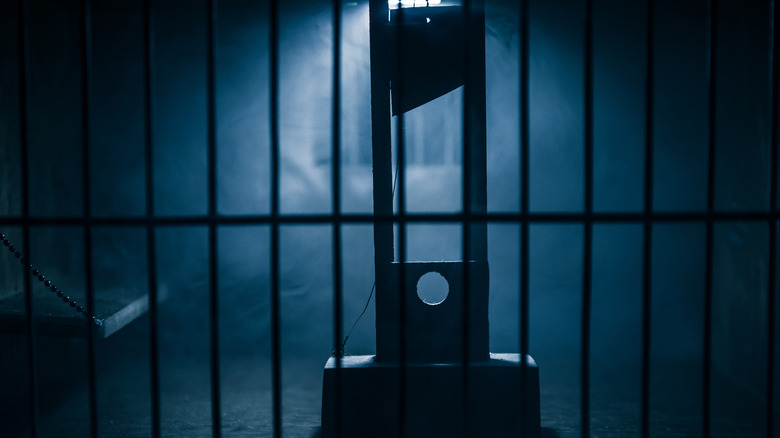What Happens To Your Body When You Die By Guillotine
Compared to some grim execution methods, beheading, in theory, seems somewhat quicker and more humane. In reality? Not always. According to Sky History, for instance, the May 1541 execution of the Countess of Salisbury, Margaret Pole (ordered by notorious Tudor head-lopper Henry VIII), was an unmitigated disaster. The inexperienced executioner supposedly delivered a total of 11 blows before severing her head.
The guillotine, per Britannica, rose to prominence in France early in the 1790s. It was invented by surgeon Antoine Louis, but came to be named after Joseph-Ignace Guillotin, who helped pass a law that made it the "official" manner of execution. Here's what happens to the body of somebody who is executed by this supposedly quick and painless device.
The guillotine's design took the sort of imprecise blade-brandishing that Margaret Pole had to suffer out of the equation. Human error and unsteady hands weren't a factor. How It Works Daily explains that Antoine Louis used his surgical knowledge to create a ruthlessly efficient system: a simple wooden frame, a lunette (the circular space the victim's head occupies), and a blade at just the right angle and weight. The executioner need only pull a length of rope to raise the blade and release it to let it fall, performing a clean, swift cut to the prisoner's neck.
The brain may live on momentarily
As Salon reports, effective and efficient it may be, but the guillotine isn't necessarily a painless and immediate manner of death. The brain may not be aware of what has happened for long before death, but there may be a brief moment (just seconds) of both pain and awareness. Salon states that some discourse suggests that the brain would use up all remaining oxygen after the head is severed from the body in around seven seconds.
The Conversation goes one step further, explaining that while the many blood vessels in the neck would be severed, the muscles still connected could still be capable of movement of facial features for a brief period, as their current supply at the point of decapitation would remain for a brief moment. According to How Stuff Works, an effective guillotine decapitation has no direct impact on the brain, and so some fleeting retention of consciousness and awareness is possible until the devastating blood loss swiftly ends it.
The implications of an awareness of one's own decapitation are horrific. Damn Interesting shares the tragic tale of a Korean War veteran who was riding in a taxi with a friend in 1989 when another vehicle struck theirs. The impact tore their companion's head from their body, and the witness recounted, "his eyes moved from me, to his body, and back to me."

